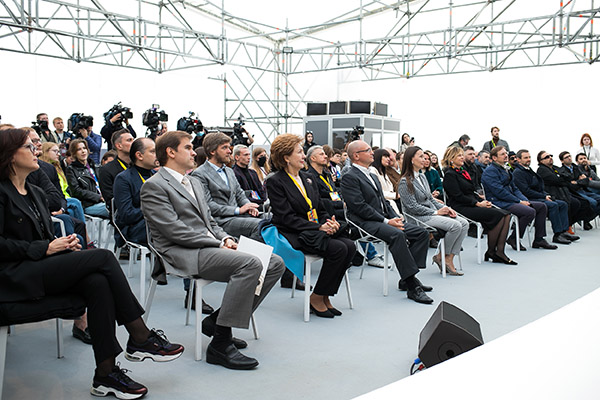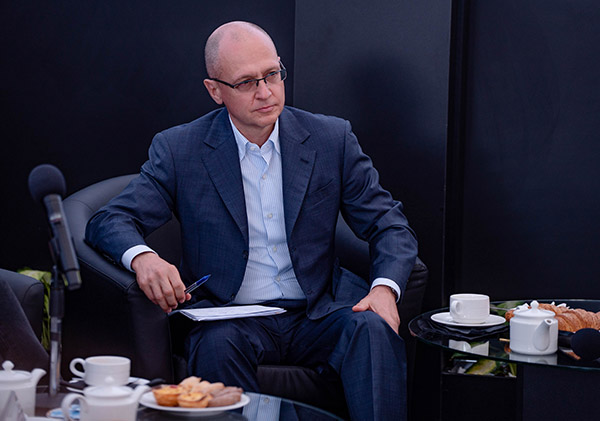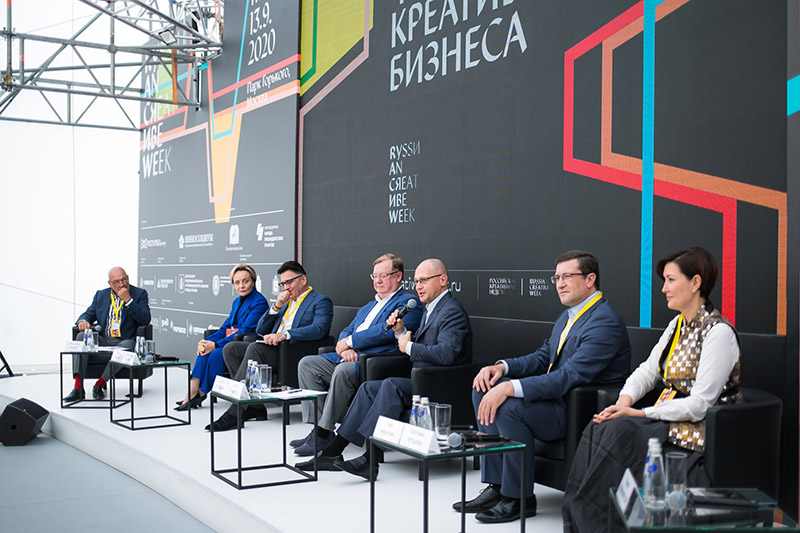[Analytics] Russian Orange that’s still green: What the country’s creative industries awaits

Participants at the first Russian Creativity Week. Photo: Event's press service.
It’s called the ‘cultural and creative industries’ (CCI) in the UK, or the ‘orange economy’ in LatAm countries. Nobody in the world knows exactly what it is, however, the whole world knows that the role of creative industries is growing. The global creative goods market grew from $208 billion in 2002 to $509 billion in 2015, according to the ‘Creative Economy Outlook’ by UNCTAD. UNESCO in its report ‘Cultural Times’ (2015) notes that 11 CCIs generate $2,250 billion a year, i.e. 3% of world GDP. Pan Pacific Agency was trying to understand what share of this gigantic volume Russia could claim.
Oil or cartoons?
Figures cited above are fairly well-known, and not the most recent besides, but research on creative industries on a global scale has not been conducted later. “People are the second oil,” Russian heavyweight politician Sergei Ivanov said back in 2009, referring to the fact that people are a key resource in the knowledge economy. Years down the line, oil prices have dropped significantly, and Russians like to talk about the “Masha and the Bear” cartoon’s export success. They known for their ingenuity and creativity, but are Russians at play on the global race for creativity leadership ex aequo?
At the first glance, it seems that they don’t. In 2014, Russia exported goods from creative industries worth $2.3 billion, and imported – $8.9 billion, according to the Creative Economy Outlook. Not least, an imbalance in trade with China has formed such a big minus. Exporting there goods worth $43 million, Russia imported from there goods worth $3.6 billion. The creative industries trade balance of services for the same time looks more successful for Russia. But all the same, services’ imports ($12.8 billion) exceeded exports ($11.2 billion). For comparison, Russia’s crude oil export exceeded $153 billion in 2014.
Sergei Ivanov’s phrase about “people as new oil” was repeated more than once at the first Russian Creativity Week, which took place in Moscow in the past week. The organizers of the event focused on 14 creative industries, although “this list will change at a high rate, as early as 2021,” Sergei Kiriyenko, the first deputy chief at the Russia’s Presidential Executive Office, said during the Creative Business Forum.
Without doubt, the Russian city where the most out-of-the-box things are happening is Moscow. The country’s capital “is ahead of most Western capitals in terms of growth rates of creative industries,” Sergei Kiriyenko believes. Svetlana Chupsheva, CEO at the Russian state-run Agency for Strategic Initiatives (ASI), echoes his words:
Britain’s creative industries produce 14% of the country’s GDP, Germany’s – around 10%. In Moscow, the same indicator is 19%, in St. Petersburg and Ivanovo – 12%, in Tyumen – 9%.
“These figures are quite competitive with the cities of the world,” Ms. Chupsheva says. ASI’s calculations are based on inclusion in the creative industries of any sector of the economy, in which the share of creative labor exceeds 50%.

Truth be told, the independent data is less complimentary for Moscow, but they confirm that in all world capitals the role of creativity is essential. The creative industries share in London is 10.63% of GDP, Berlin – 9.95%, New York – 8.91%, Seoul – 7.42%, according to the creative capital index of global cities by Calvert 22 Foundation and PwC in Russia. In 2012-2015, the creative industries formed 5.66% of the Moscow’s GDP, according to these calculations. In 2017, Russian govt analytical center estimated the volume of CCIs in Moscow at 9.5%, in St. Petersburg – at 7%.
So, you can count it as you like, but the capital of Russia is estimated far from the last place in the “new oil” production worldwide. However, creative industries are barely visible across the country. Sofia Trotsenko, the founder of the Moscow Center for Contemporary Art Vinzavod, said, that creative industries produce less than 0.5% of the country’s GDP, as the corresponding figure in developed countries is 5-8%. “The potential is high, but how to turn it into an economic activity shaping is a big question,” the businesswoman says.
Small markets – lots of rules
CCIs have a lot of problems, Russian officials understand. Some of problems are related to the lack of a market, for example, paid-for advertisement through graffiti are not allowed, Sergei Novikov, the head of the public projects department at the Presidential Executive Office, says. Such a permit “would give street art several times more funds than it can raised during graffiti festivals”.
Bureaucratic rules are another reason for the CCIs problems. Many companies in the creative industry find it difficult to obtain tax breaks for IT companies, Mr. Novikov continues. One Russian well-known company that preparing computer special effects for the movie is an IT company in fact. But it cannot receive a zero rate of contributions to the statutory social and pension insurance schemes, because the tax service may not include in a special benefits register companies that have indicated in their registration documents ‘cinema’, but not IT, as their main activity.
Of course, in Russia not everything depends on the state, but still a lot. First of all, govt “should change its attitude towards the creative industries,” Sergei Kiriyenko says. He understands that grants and subsidies for the development of creativity “is good, but it’s definitely not enough.” It’s necessary to change state legislation to provide CCIs with broader tax incentives, as well as “find mechanisms for selecting talent at an earlier stage”, because “the mainly based on tests education system isn’t very suitable for the creative industries development,” he says.

At the same time, the official is optimistic: “Fact that the development driver is not the raw material industries, but the creative ones, is good news for Russia. Of course, Russia remains a raw material superpower. Main Russians’ features, as old fairy tales says, are creativity, unpredictability, ingenuity. All of it definitely applies to the creative industries. We know how to do this. So, we have good competitive advantages,” he says.
Creative industries in Russia are “a bit of a suitcase without a handle” now, Vinzavod founder Sofia Trotsenko says, that CCIs are suspended between “the culture, the creation of intellectual property and the entrepreneurship”. She says: “Creative industries are within the jurisdiction of the authorities responsible for culture and the authorities responsible for the economy. In creative industries, the relationship between activity and profit is not always direct and linear, rather, they affect related sectors of the economy.”
“Of course, one of the most important issues is to improve the regulatory framework on intellectual property protection. The legal definition of a term ‘creative industries’ is also necessary, because it’ll help to highlight the subjects of such activities and to set special tax regulation and incentives for them,” Ms. Trotsenko says.
Heavy state
State’s weight on the market is reducing while market is developing, but it should not disappear at all, Olga Paskina, the CEO at the National Media Group, CJSC, highlights. “When the Ministry of Culture began to focus its resource and its attention on cinema, the share of Russian cinema in the film distribution and exhibition increased (the share grew from 4.2% to 23% over the past 10 years. – Ed.), and we became number one in Europe. Russia’s share in the export of European cinema is surpass Germany’s share and is 5% now, though this result was achieved relatively recently,” the media manager says. At the same time, even in the developed film markets, such as France or Italy, the state’s share is a quarter.
State’s presence is one of the two main problems for the development of Russian media, Egor Altman, the founder of the Alt Communication Group advertising agency, adds. “It would be useful if the state reduced the volume of its presence in the media. This would unload the industry, make it relaxed and free. Those spheres where the state’s presence is minimal, i.e. blogs and social networks, are beginning to take away a large percentage of the target audience from the media,” he emphasizes.
The development of creative industries is hard without govt attending, officials claim. In Moscow and St. Petersburg, where tourists meet with cultural values, “it’s possible to recoup the costs of creativity”, Maxim Ksenzov, the Russian deputy minister of culture, who oversees digitalization, says. In the province, the task is more difficult: here, for cultural values availability by everyone, both tourists and residents, the state needs to create “a kind of platform service, a digital image of certain objects or cultural organizations.”
“Any business is built around assets. Govt to keep cultural values, exhibits in museums, making them available to everyone. The ecosystem around values can raise money, creating an industry. My goal is to develop new platforms that will allow the creation of new businesses,” the official says. In the near future, the govt plans to digitize 70-80 million exhibits throughout the country. “Our task is to make sure that the images of these exhibits, observing copyright, can be used by business. What usage conditions must be issued, it should be regulated by the market,” he said.
Crisis and opportunities
One way or another, so far, creative industries cannot go through a crisis without state support. Alexander Zharov, CEO at the Gazprom-Media Holding, the largest media company in Eastern Europe, citing data from the Russian Union of Industrialists and Entrepreneurs, estimates the pandemic losses of the creative industries in Russia, excluding the IT sector, at 120-150 billion rubles. “It is clear that the creative industries are very vulnerable and require government support,” he said. According to the president of the Russian Book Union, former Russia’s PM Sergei Stepashin, the country’s book industry “lost 30 billion rubles due to the pandemic.” Mr. Stepashin estimates the annual turnover of the book market at 92 billion rubles. “Thanks to the government, they supported us, included the book industry in the list of pandemic-hit industries,” he says.

The pandemic will recede sooner or later, but what next? In 2017, the Analytical center of the Russian govt called the creative industries “with significant potential for growth.” “Unlike international practice, where television is the absolute leader, among the domestic creative industries the first line belongs to the field of information technology, software and computer services, the second to advertising and marketing, and the publishing industry closes the top three in terms of profitability,” analysts write.
“The creative industry can become one of the important areas of GDP growth, and its contribution can quadruple in less than 10 years,” they are sure.
“The creative industry is in the focus of attention of the state. The future of the industry is directly related to the growth of state interest, openness to interaction, and its thoughtful participation,” Teresa Mavica, V-A-C Foundation co-founder and director, said based on the results of the Russian Creativity Week. “It’s important to state that the creative industry needs a holistic approach, therefore the formation of a unified map of the country’s creative initiatives is becoming our primary task,” the press service of the event quoted the expert.
In some West developed countries, state programs for supporting creative business have been realizing since the 90s. It’s not bad, that the dialogue between Russian govt and “orange economy” started now at the least.
Dmitrii Shcherbakov is the Russian journalist since 2006, he is also a Pan Pacific Agency’s managing partner. Russian version of this article is available here.